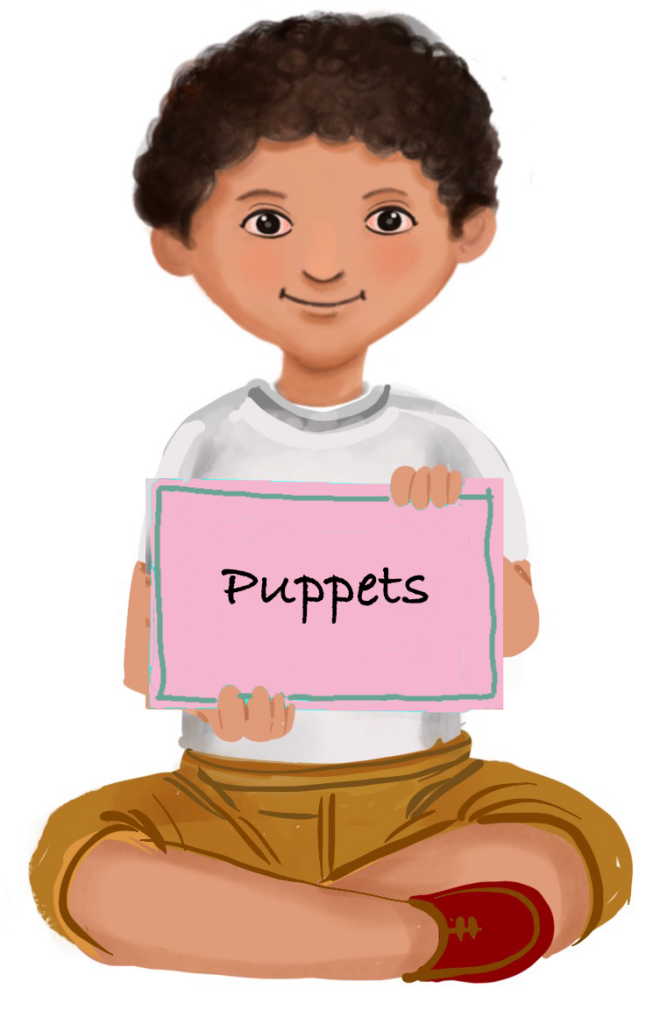
Face of Woman
 Objective
Objective
To help teachers in creating a puppet of a woman’s face for story-telling and other purposes.
Estimated time to create the Face of Woman
30 to 45 Minutes
Materials required for creating Face of Woman
- Thick chart paper- Yellow colour- for the Face, Nose, Ears and paper pipe
- White chart paper – small pieces for eyes and lips.
- Black chart paper – for the hair
- Stapler with pin
- Pencil
- Fevicol
- Scissors
- Marker Pens – Black and Red
Preparation for Activity
Keep the materials ready. If you are using hot glue instead of Fevicol, ensure that the hot glue is heated suitably and is ready for use.
Procedure
- This face puppet is relatively bigger in size.
- First, draw and cut the shapes of nose and ears and set them aside.
- Cut the shapes for the eyes and lips, colour them appropriately and set them aside as well.
- For the hair, take a wide strip of black chart paper long enough to fix around the forehead.
- Make thin cuts along the entire length of the strip, cutting up to 3/4ths of the width of the paper. Be careful not to cut too close to the edge. The hair is now ready.
- For the face, take a wide strip of yellow coloured thick chart paper.
- Roll the chart paper into a hollow cylinder, so that the shorter edges overlap.
- The overlap should be smaller at the top and gradually widen at the bottom to make the Jaw narrower than the forehead.
- Hold the overlap in place and staple the top and bottom of the sheet. The hollow face is now ready.
- For the hair, apply fevicol along the uncut edge of the black strip and stick it around the broader side of the head.
- Use fevicol, to attach the nose at the centre of the face and the ears on the sides.
- Apply fevicol to the back of the eye pieces and stick them on the face, spacing them equally from the nose.
- Similarly stick the lips, just below the nose.
- Draw eyebrows, using black marker.
- Using a red marker pen, draw a Bindi on the forehead.
- Trim paper along the jaw and sides to smoothen the face shape as needed.
- To make a paper pipe for the handle, take a strip of yellow chart paper. Roll it to fit the size of your hand and paste the edges to form the pipe.
- Place the pipe, inside the hollow portion of the face, behind the nose and lips. Fix it using fevicol.
- Allow a few minutes for the Fevicol to dry and the puppet is ready.
- Insert your hand into the paper pipe to animate the girl or woman character.
Step by Step Pictures to create the puppet
Important Tips
- Instead of using black coloured paper for hair, we can attach a ‘creeper’ (artificial hair used in drama makeup) for a more realistic look.
- Wedding cards/ book covers can be used instead of drawing sheets.
- For reference we can take images from drawing books or the internet.
- While creating the puppet, replicate the character illustration given in the children’s textbook. Once the puppet is ready, use the character’s name from the textbook. Using the name in the textbook helps children to remember the content.
- The teacher should use the puppet at an appropriate time. The teacher can narrate the story in a humorous manner. The teacher may make intentional mistakes to encourage children to correct them, thereby helping them become more actively engaged.
Precautions
Precautions to be taken while manipulating finger puppets:
- Always keep the face of the puppet towards the audience.
- The focus of the Puppet Master should be on the puppet.
- Puppets that are talking are only activated. Other puppets should remain in a still position.
Troubleshooting:
- While making a paper pipe, take the exact size of your finger/hand which you are using. It aids in the proper movement of the puppet.
- Use a cutter to make holes.
- Holes that you are making should be exactly the size of your fingers. If the hole is big, the puppet will not fit on your fingers. If the hole is small, you cannot insert your fingers.
 Notes to the Teacher
Notes to the Teacher
Puppets can be used in the classroom to teach children about emotions. They are a valuable tool for teaching rhymes, songs, stories and more. Using puppets also aids in developing motor skills, such as hand-eye coordination. Additionally, puppets can enhance communication and social skills, improve focus and concentration and help teach concepts and values.
Using the Learning Teaching Material
The teacher can demonstrate a ‘Puppet Show’. Teachers can encourage the students to create these puppets and have a ‘Puppet Show’ in the classroom.
Video: How to use Learning Teaching Material
| Source and Attribution of images All images used in the above Assets and Aids are originally created. |
| This digital material has been developed by the Sri Sathya Sai Vidya Vahini Inclusive Education Project, a unit of Sri Sathya Sai Central Trust, Prasanthi Nilayam, as a collaborative offering in the service of our nation. |